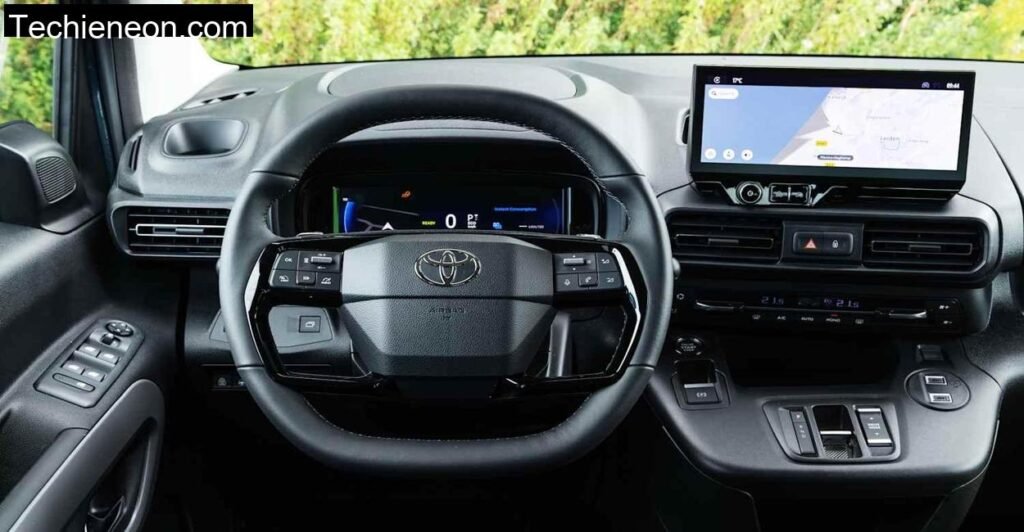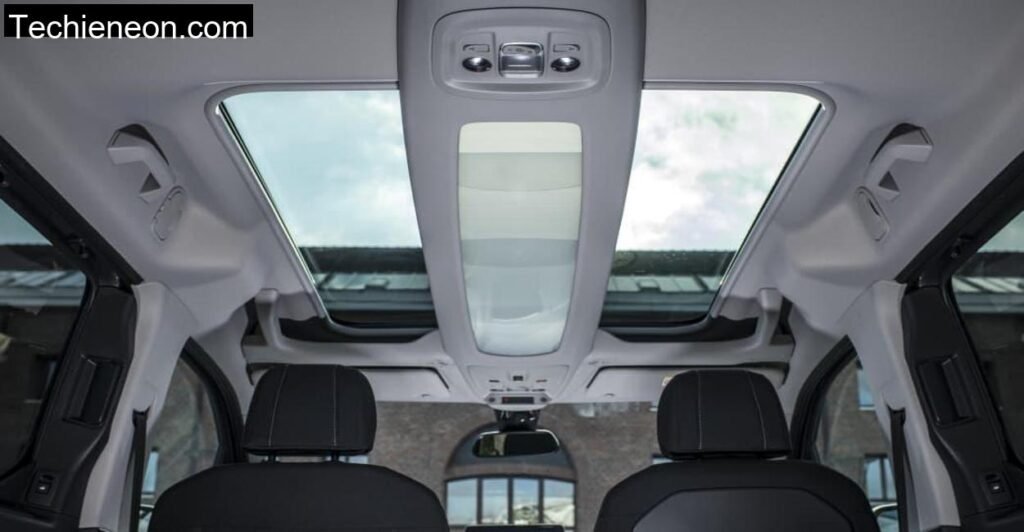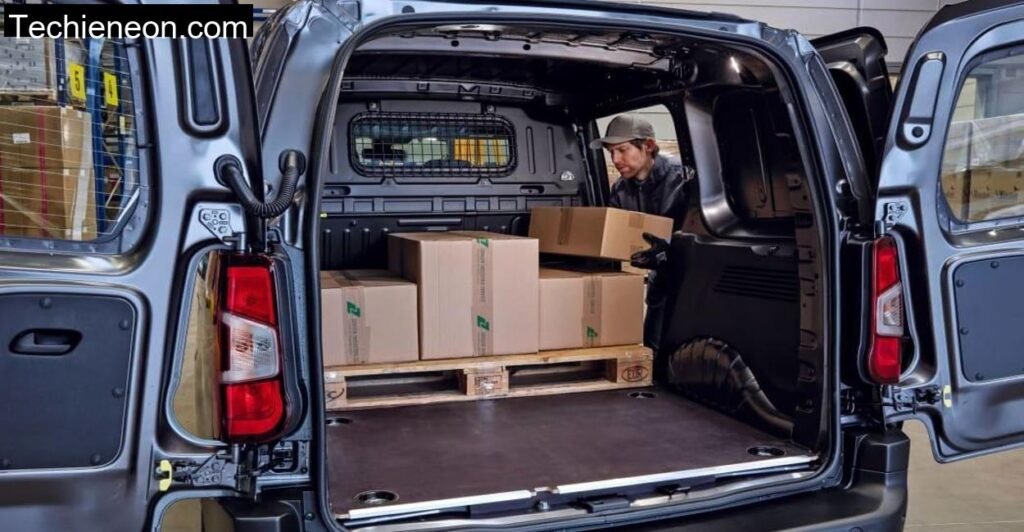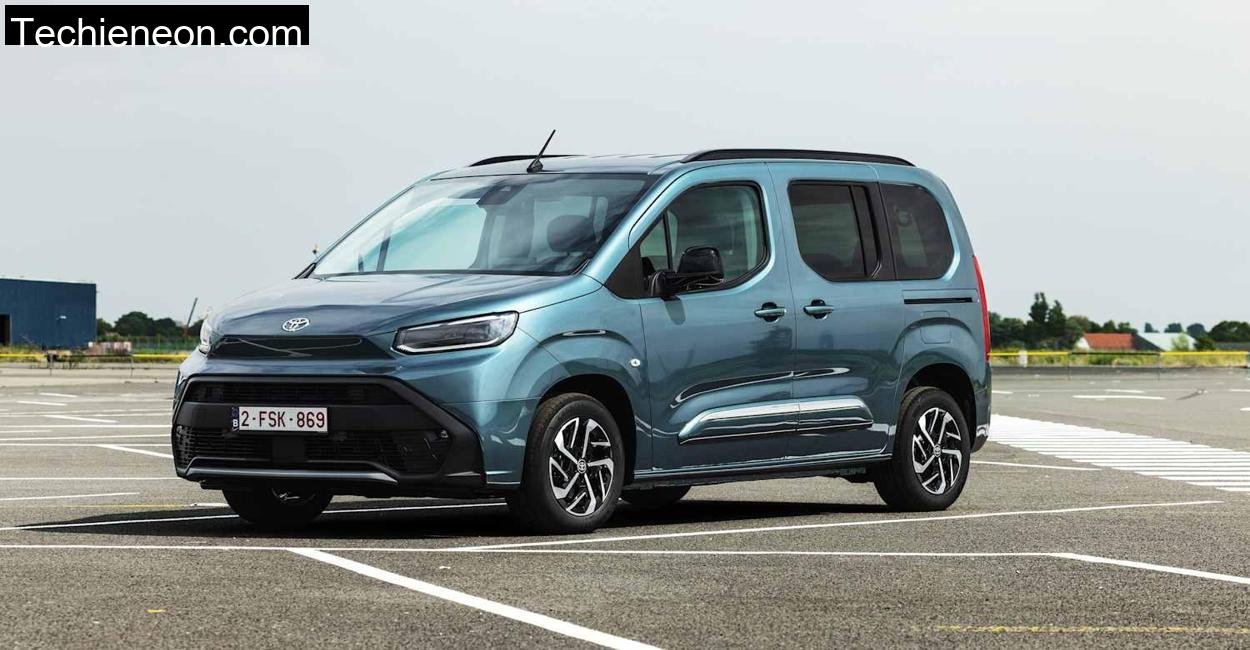There’s something disarmingly honest about the Toyota ProAce City Verso. No pretensions of luxury or sportiness, no glitzy marketing promises, it just quietly shows up, ready to carry people, gear, dogs, planks of wood, or your weekly family shop. And sometimes, that’s exactly what you need. We took it to Lausche, Saxony’s highest mountain at the German-Czech border, not because it’s a place one normally thinks of testing a high-roof station wagon, but because the winding forest roads, steep inclines, and gravel-strewn paths there have a habit of revealing what a vehicle’s really made of. Spoiler: The ProAce City surprised us.

ProAce City Verso: Five or Seven Seats
We tested the “Team Germany” trim of the Toyota ProAce City Verso in short wheelbase form. From the outside, it looks like a softened delivery van wearing a Toyota mask. Inside, things are less utilitarian than you’d expect. Sure, hard plastics dominate, but they’re not offensive, just built to last. Everything feels solid, like it was designed with sticky fingers, wet jackets, and occasional flying juice boxes in mind.
The test car had five seats, all generously spaced and surprisingly comfortable, even after a two-hour climb and descent through Lausche’s southern ridge. The optional seven-seater configuration (available with the long-wheelbase model) would probably be welcome for larger families, but the five-seat version makes better use of the boot and rear passenger legroom. Sitting behind myself (I’m 1.85 meters tall), I had more than enough knee and headroom to avoid that usual compact-MPV knee-clash situation.
One thoughtful detail stood out: the rear sliding doors. In tight trailhead parking lots where regular doors would bang into trees or rocks, they simply glide open, quietly brilliant.
Panel Van With One Tonne Payload
Despite testing the passenger-focused Verso model, you can’t forget this car shares its DNA with a full-blown workhorse. The same bones support the ProAce panel van variant, capable of swallowing up to a tonne of payload.
That utility crept into our drive, too. We hauled a mountain bike, a tent, and a crate of supplies for an overnight stop at the Lausche fire tower, packed with room to spare. With the rear seats folded, the flat load floor accommodated everything, and the separately opening rear window made grabbing jackets without swinging open the boot a daily convenience.
For the trade user, that flexibility isn’t just nice, it’s necessary. And it’s easy to see this as a double-duty machine: school run by weekday, mountain bike base camp by weekend.
Engines: Petrol, Diesel, Electric
Under the hood, our ProAce Verso ran Toyota’s 1.2-liter turbo petrol engine, sourced from Stellantis. It’s good for 110 hp and 205 Nm of torque, modest numbers on paper, but it never felt underpowered during our test.
The 1.5-liter diesel, available in two power levels (102 hp and 130 hp), would probably be the smarter pick for long-distance hauls or trade use. And for the city-dwelling eco-conscious, the electric variant offers 136 hp and a 50 kWh battery, good for shorter urban missions, though the high entry price remains a hurdle.
Out in Lausche, we didn’t crave more power. The turbo petrol pulled confidently up inclines and cruised effortlessly on the Autobahn stretches leading to the Zittau Mountains. Gears are well spaced in the six-speed manual, and though a little notchy, it slots home with satisfying precision.
Test Consumption: 7.1 l/100 km
Fuel economy is rarely the headline for vans-turned-MPVs, and that remains true here. The ADAC test figure of 7.1 l/100 km held true for our real-world journey,6.9 on the motorway, climbing to just over 8 l/100 km in hilly forest tracks and tight village detours.
It’s not record-breaking, but considering the size, shape, and lack of mild-hybrid wizardry, it’s not bad either. You’re moving a boxy 1.5-tonne vehicle, after all. The emissions performance, however, is solid enough to earn it three stars in the ADAC Ecotest, which adds a bit of feel-good to your fuel bills.
Driving Behavior: Safe, But Not Very Dynamic
Here’s the thing, the ProAce isn’t fun in the “spirited” sense. It leans in corners, its steering is vague, and when pushed, it quickly tells you it’d rather not. But what it is, and here’s where Lausche helped reveal this, Is unshakably safe.
The ESP cuts in assertively when you carry too much speed into tight bends. It doesn’t hesitate, it just grabs the situation by the collar and brings everything back under control. And that’s comforting.
Ride quality, surprisingly, is car-like. On broken forest paths, the suspension absorbed rocks and potholes without shuddering through the cabin. There’s a gentle bounce at higher speeds, typical of vans, but it never felt unsettled.

Plenty of Space for Passengers and Luggage
Where the ProAce City Verso truly shines is interior space. Front seats are upright and commanding, like a crossover. Rear space is even more generous. At one point, we took shelter from a mountain shower inside the cabin with three people, two backpacks, and a hot Thermos, no elbows were bumped.
Headroom is cathedral-like. Even with a hat on, I didn’t brush the ceiling. There’s storage above the windshield, in the door bins, under the seats, and even an overhead gallery with compartments that feel pulled from a long-haul bus.
With the rear seats up, you still get 641 liters of trunk volume. Fold them down, and it swells to over 2,100 liters, perfect for bulky gear or IKEA adventures. This is a car that laughs at your packing anxiety.

Technical Specification
For accuracy and reliability, all technical info is sourced instantly from the official websites of Toyota’s.
| Specification | Value |
| Engine Type | Petrol (Turbocharged) |
| Displacement | 1,199 cc |
| Power Output (kW / hp) | 81 kW / 110 hp |
| Torque | 205 Nm |
| Transmission | 6-speed manual |
| Drive Type | Front-wheel drive |
| 0–100 km/h | 13.0 seconds |
| Top Speed | 174 km/h |
| Fuel Consumption (WLTP) | 6.3 l/100 km |
| CO₂ Emissions (WLTP) | 143 g/km |
| Boot Capacity (seats up) | 641 liters |
| Boot Capacity (seats folded) | 2,126 liters |
| Payload | 684 kg |
| Braked Towing Capacity | 1,100 kg |
| Dimensions (L x W x H) | 4,401 x 1,848 x 1,812 mm |
| Weight (EU) | 1,366 kg |
| Warranty | 3 years / 100,000 km |
| Base Price (Germany) | €32,480 |
Conclusion
The Toyota ProAce City Verso doesn’t make bold statements. It doesn’t chase performance metrics or interior opulence. But what it does offer is honesty, space, flexibility, and a deeply practical design. In Lausche, it felt as at home parked under pine trees as it did rolling through Dresden’s cobbled old town streets.
It’s not a car for dreamers. It’s a car for doers. For people with bikes to haul, kids to collect, or clients to meet. It’s a van dressed in car clothes, or a car with the heart of a van, depending on how you look at it. And that makes it one of the most useful, under-the-radar family vehicles out there today.
Is the Toyota ProAce City Verso suitable for long road trips?
Absolutely. With generous space, decent comfort, and solid fuel economy, it makes long journeys a breeze, especially if you value practicality over polish.
How does the Toyota ProAce compare to its Stellantis siblings (Berlingo, Rifter, etc.)?
Mechanically, it’s identical. The main differences are styling and trim availability. Toyota also provides a strong dealer network and a slightly different ownership experience.
Is Toyota ProAce City worth choosing the electric version?
If your driving is mostly urban and you have access to charging, the electric ProAce makes sense. For mixed or long-distance use, the petrol or diesel models are more flexible.



Leave a Comment